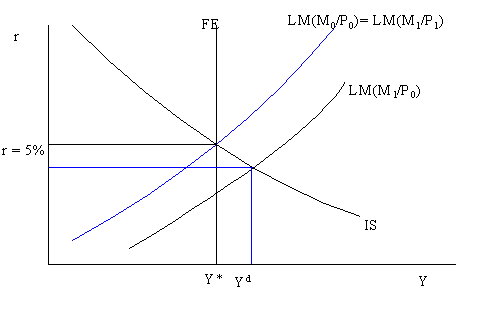
Reading: AB, chapter 10

Consider the economy initially in general equilibrium with r* = 5% and full employment output Y*. Recall, in general equilibrium the labor market is in equilibrium, the goods market is in equilibrium (aggregate demand = aggregate supply) and the money market is in equilibrium. The initial price level is given by P0. Now suppose the Fed increases the nominal money supply, through an open market purchase of government bonds, from M0 to M1. This shifts the LM curve down and to the right and increases the demand for goods by putting downward pressure on the real interest rate. The level of demand is determined by the intersection between IS and LM and this is denoted Yd. At the higher level of real balances the aggregate demand for goods is greater than the aggregate supply of goods, Y*. Firms will see their inventory of goods fall and they will respond by increasing prices. Workers react to the increase in prices by bargaining for higher nominal wages to keep their real wage constant. As overall prices and wage rise, the LM curve will shift up and to the left reversing the downward pressure on the real interest rate. Prices rise so that the LM curve shifts right back to where it was initially. The expansionary monetary policy in this example is completely neutral on the real economy: the increase in M has caused no change in the equilibrium values of the real variables Y, r, W/P. The higher money supply has increased the price level and the level of nominal wages and has caused a brief spurt of inflation.
[ Previous Slide] [Next Slide] [Contents for Lecture 9] [Slides from Lecture] [301 Homepage]
Last updated on July 22, 1996 by Eric Zivot.